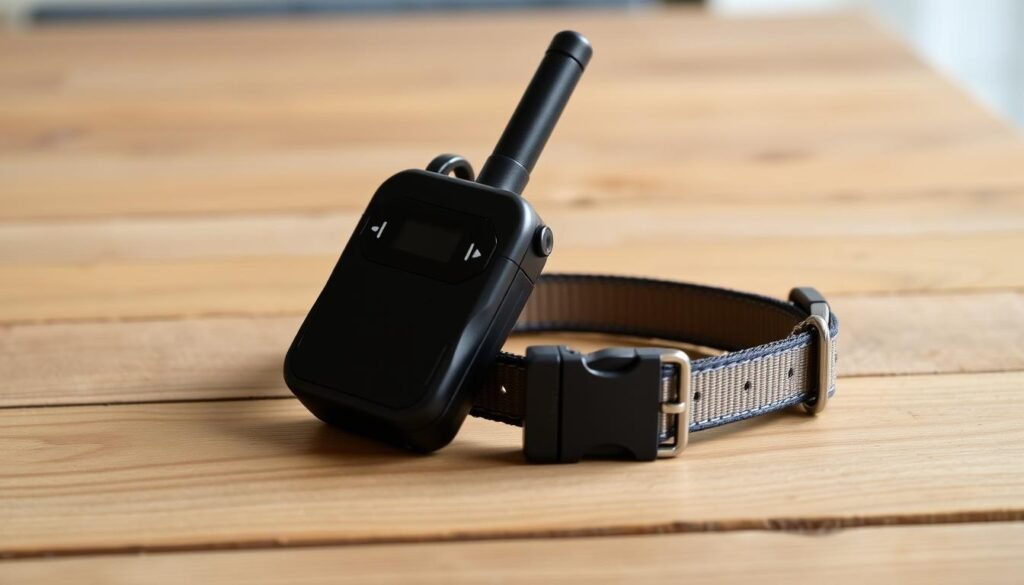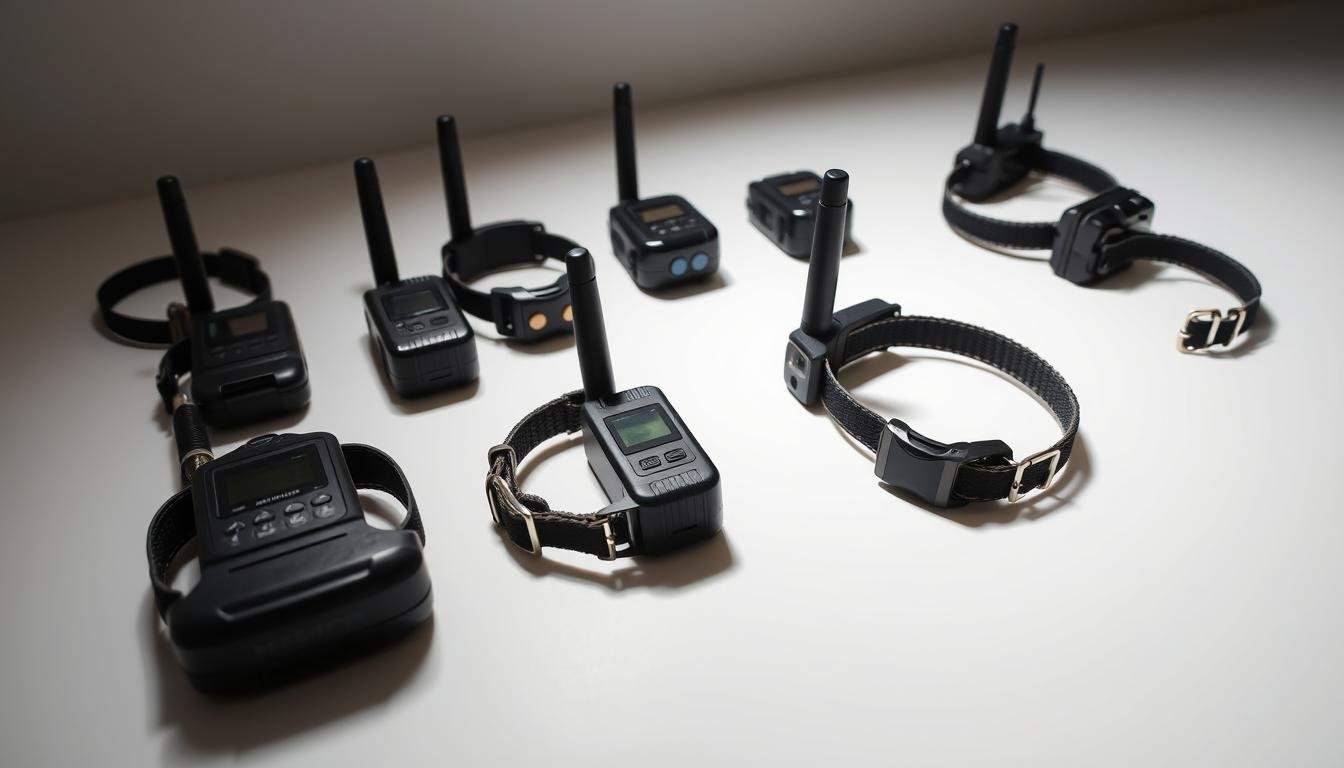Remote Dog Training Collars: Pros, Cons & Best Options
Table of Contents
Are you having trouble with your pet’s behavior? You’re not alone. Many dog owners struggle with training their pets, especially with obedience and setting boundaries.
Remote dog training collars are a helpful tool. They offer quick corrections and control from a distance. These devices are great for owners who need their pets to listen even when they’re far away.
Knowing the pros and cons of these collars helps you decide if they’re right for your pet. In this article, we’ll look at the good and bad sides of remote training collars. We’ll also show you some top choices.
What Are Remote Dog Training Collars?
Remote dog training collars are key for dog owners wanting to improve their training. They give dogs feedback to help with bad behavior and learning commands.
The Purpose and Function of Training Collars
These collars, known as remote controlled dog training gadgets, help owners train dogs from afar. They allow owners to communicate with their dogs, correcting bad behavior.
Collars work differently, with some using static, others vibration, and some a tone to stop bad actions. The right collar depends on the dog’s personality and training needs.
How Remote Training Systems Work
Remote dog collars for behavioral training have a transmitter and a receiver collar. The owner sends a signal from the transmitter to the collar. The collar then gives the dog a signal, like a beep, to stop bad behavior.
These systems work by giving dogs instant feedback. This helps them learn what behavior is wrong. Used right, they’re a great tool for training dogs.
Knowing how remote dog training collars work helps owners decide if they’re right for their dog. It’s all about making the right choice for your pet’s training.
The Evolution of Dog Training Technology
Dog training collars have changed a lot, moving from simple to advanced tools. Today’s technology offers many new features. These help make training better and safer for dogs.
From Basic Shock Collars to Modern Training Tools
At first, dog training collars were just shock collars. They used static shock to stop bad behavior. But, they had some problems and were not perfect.
Now, we have remote dog training collars with many options. They can use vibration, tone, or even spray. This meets different dogs’ needs. Plus, they have GPS and smart tech. This lets owners track their dogs and get insights on their behavior.
“The best way to train a dog is with positive reinforcement, and modern training collars are designed to work in harmony with this approach.”
Recent Innovations in Remote Training Devices
New remote training devices are better in many ways. They offer advanced remote dog training devices with longer range and rechargeable batteries. They also let you set up training plans just for your dog.
| Feature | Basic Collars | Advanced Collars |
|---|---|---|
| Stimulation Type | Static Shock | Vibration, Tone, Spray, Static |
| Range | Limited | Up to several miles |
| Customization | Limited | Highly customizable |
Benefits of Remote Dog Training Collars
Remote dog training collars are a great way for dog owners to improve their pet’s behavior. They are a key tool in modern dog training. They offer many benefits that make training easier and more effective.
Enhanced Off-Leash Control and Safety
Using remote trainers for dogs lets you control your pet even when they’re not on a leash. This is super useful in open spaces where your dog might wander off or get into trouble. With a remote collar, you can correct your dog’s behavior from a distance. This keeps them safe and gives you peace of mind.
Effective Behavior Modification
Recommended remote training collars help change your dog’s behavior for the better. They can help with issues like barking, jumping, and more. By linking the correction to the bad behavior, your dog learns to behave better. This makes your relationship with your pet much better.
Versatility for Different Training Scenarios
Remote dog training collars are very versatile. They work for all sorts of training, from basic obedience to complex tasks. They fit your training needs, whether you’re in a controlled space or out in the field. A remote collar is a valuable tool for achieving your training goals.
Potential Drawbacks and Concerns
Remote dog training collars have many benefits but also some drawbacks. Dog owners need to know these concerns for safe and effective use.
Physical and Psychological Impact Considerations
Remote dog training collars can affect dogs physically and mentally. Physical impacts can be from mild discomfort to serious health problems if not used right. Psychological impacts, like anxiety or stress, can happen if the collars are used wrong or too much.
| Potential Impact | Description | Mitigation Strategy |
|---|---|---|
| Physical Discomfort | Minor to serious health issues due to improper use | Follow manufacturer’s guidelines, monitor dog’s reaction |
| Psychological Stress | Anxiety or stress caused by misuse or overuse | Use positive reinforcement training methods alongside the collar |
Risks of Improper Use
Improper use of remote dog training collars is a big concern. It can come from not understanding the device, fitting it wrong, or using it as punishment. Proper training and understanding of how to use these collars are key to avoid harm to the dog.
When Remote Collars May Not Be Appropriate

Remote dog training collars might not be right for every dog. Dogs with health issues or those that are very sensitive or anxious might not be good candidates. It’s important to think about your dog’s needs and consider other training methods if needed.
In conclusion, while remote dog training collars are useful, it’s vital to know their potential downsides. By being aware of these concerns and using the collars responsibly, dog owners can ensure a safe and effective training process.
Types of Remote Dog Training Collars
Remote dog training collars come in many types. Each is made for different training needs and dog personalities. It’s important to know the differences to pick the right collar for your dog.
Static Stimulation Collars
Static stimulation collars are very common. They send a static pulse to the dog when you press a button on the remote. You can adjust how strong the pulse is to fit your dog’s needs.
Pros: They work well for quick corrections, and you can change the intensity.
Cons: They might hurt or upset your dog if used wrong.
Vibration-Based Training Systems
Vibration-based systems use a vibration to get your dog’s attention. They’re a gentler option than static collars. They’re good for dogs that don’t like static.
Pros: They’re kinder, work well for sensitive dogs.
Cons: They might not work for dogs with strong instincts or those easily distracted.
Tone/Beep Training Options
Tone or beep collars use a sound to tell your dog to stop bad behavior. They’re often used with positive training methods.
Pros: They’re soft and don’t hurt, great for positive training.
Cons: They might not work for dogs that don’t listen to sounds or get easily distracted.
Spray Deterrent Collars
Spray deterrent collars release a bad smell to stop bad behavior. They’re seen as kinder and can work for some dogs.
Pros: They’re gentle, can stop certain bad behaviors.
Cons: You might need to refill the spray often, and some dogs might get used to the smell.
| Collar Type | Key Feature | Pros | Cons |
|---|---|---|---|
| Static Stimulation | Adjustable static pulse | Effective, adjustable intensity | Potential discomfort or pain |
| Vibration-Based | Vibration signal | Humane, effective for sensitive dogs | May not work for strong prey drives |
| Tone/Beep | Distinct sound | Gentle, non-invasive | May not work for distracted dogs |
| Spray Deterrent | Unpleasant scent release | Humane, effective for certain behaviors | Requires refill, potential desensitization |
Knowing about the different types of remote dog training collars helps you choose the best one. It depends on your dog’s needs and your training goals.
How to Choose the Right Remote Training Collar
Finding the right remote training collar is key to good dog training. With many remote controlled dog training gadgets out there, picking the right one can be tough.
Matching Collar Type to Your Dog’s Size and Temperament
When picking a collar, think about your dog’s size and personality. Small dogs need collars that don’t hurt them. Big, stubborn dogs might need stronger collars or extra features like GPS.
A recommended remote training collar for small dogs might just use vibrations or tones. But bigger dogs might need collars with static stimulation that you can adjust.

Essential Features to Consider
There are key features to look at when choosing a collar. These include the type of stimulation, how far the remote can reach, and extra features like being waterproof or having long battery life.
- Choose a collar with different stimulation types to match your dog’s needs.
- Make sure the collar’s range fits your training space, whether it’s for walks or in a yard.
Range, Battery Life, and Durability Factors
The collar’s range, battery life, and how well it lasts are very important. A collar with a long battery and quick recharge is very handy.
It’s also important for the collar to be tough, especially if your dog is active or works outside. A waterproof and sturdy design helps it work well in all kinds of weather.
Top-Rated Remote Dog Training Collars for 2023
2023’s best remote dog training collars are more advanced than before. They come with features to make training better and more effective. We’ll look at some top models, sorted by performance, price, size, and versatility.
Best Overall: SportDOG and Garmin Models
The SportDOG and Garmin models lead the pack in 2023. They are reliable, packed with advanced features, and work well in many training situations.
- SportDOG Brand: Offers a range of collars with customizable stimulation levels and advanced training features.
- Garmin Models: Combine GPS tracking with training, perfect for those who need to keep an eye on their dog’s location and behavior.
Budget-Friendly Options: PetSafe and Educator Brands
PetSafe and Educator Brands offer quality collars at a lower price. They have the basics for basic training needs.
| Brand | Model | Key Features | Price |
|---|---|---|---|
| PetSafe | PETSAFE Gentle Leader | Static, Vibration, Tone | $99.99 |
| Educator | EDUCATOR E-Collar | Customizable Stimulation, Remote Training | $129.99 |
Best for Small Dogs: DogCare and eXuby Systems
Small dogs need collars that are gentle yet effective. DogCare and eXuby Systems have collars made for smaller breeds, ensuring safe training.
- DogCare: Has adjustable stimulation levels and a design for small dogs.
- eXuby: Provides a waterproof collar with various training modes, great for small, active dogs.
Best for Large and Stubborn Dogs: Dogtra and SportDOG Field Trainers
Large and stubborn dogs need collars that provide consistent training. Dogtra and SportDOG Field Trainers are built for these challenges, with strong features and durability.
Most Versatile Waterproof Models
Water-loving dogs or those trained in wet conditions need waterproof collars. Many models reviewed here are waterproof, ensuring training goes on no matter the weather.
- Waterproof Models: Include brands like Garmin and SportDOG, offering durable collars for different environments.
Choosing from these top-rated collars for 2023 helps find the best tool for your dog’s training. It doesn’t matter their size, breed, or temperament.
Proper Fitting and Maintenance of Remote Training Collars
For your dog’s comfort and the collar’s effectiveness, fitting and maintenance are crucial. A well-fitted collar ensures your dog is comfortable and trains well.
Ensuring Correct Fit and Comfort
To fit correctly, two fingers should fit between the collar and your dog’s neck. Proper adjustment is crucial to avoid discomfort or injury. Check the fit often as your dog grows or the collar is adjusted.
Cleaning and Maintaining Your Training Device
Cleaning your remote training collar regularly is key. Use a soft cloth and mild soap to clean it. Pay special attention to the electrodes. Make sure it’s dry before storing.
When to Replace Components or Upgrade
Components of your collar may wear out over time. Replace worn-out parts as needed. Consider upgrading if your collar doesn’t meet your training needs anymore.
By focusing on proper fitting and regular maintenance, your remote dog training collar will stay effective. It will help you and your dog achieve the best results.
Effective Training Techniques with Remote Dog Training Collars
Success in remote dog training comes from the right techniques and how you introduce the collar. It’s key to grasp the principles behind effective training with these collars.
Getting Started: Introducing Your Dog to the Collar
First, your dog must get used to wearing the collar. Start by letting them wear it without it being active. This helps them link the collar to positive experiences.
Key steps to introduce the collar:
- Start with short sessions and gradually increase the duration.
- Reward your dog with treats and praise for calm behavior.
- Monitor your dog’s comfort and adjust the fit as necessary.
Progressive Training Protocols
Effective training with advanced remote dog training devices needs progressive protocols. These protocols challenge your dog and reinforce good behavior.
Progressive training involves:
- Beginning with basic commands and gradually introducing more complex tasks.
- Adjusting the level of stimulation according to your dog’s response.
- Consistently rewarding desired behavior.
| Training Stage | Description | Stimulation Level |
|---|---|---|
| Basic Obedience | Teaching simple commands like “sit” and “stay.” | Low |
| Advanced Commands | Introducing complex commands and distractions. | Moderate |
| Off-Leash Training | Training your dog to respond off-leash. | Variable |
Common Mistakes to Avoid
To ensure effective training, it’s crucial to avoid common pitfalls.
Timing Issues
Incorrect timing of the stimulation can confuse your dog. Make sure the stimulation is applied right after the undesired behavior.
Inconsistent Commands
Using inconsistent commands can confuse your dog. Use clear, consistent commands that your dog can understand.
Overreliance on Correction
Relying too heavily on correction rather than positive reinforcement can lead to negative associations. Balance correction with rewards for good behavior.
By understanding and implementing these effective training techniques with remote dog training collars, you can achieve significant improvements in your dog’s behavior.
Conclusion
Remote dog training collars can be very helpful in your training journey. They offer better off-leash control and help with behavior changes. But, it’s important to know the potential downsides too.
When picking a collar, think about your dog’s size, personality, and what they need to learn. Look for adjustable settings, range, and how long it lasts. Brands like SportDOG, Garmin, and PetSafe have many options. Using the right collar correctly can help you reach your training goals and make your bond stronger.

